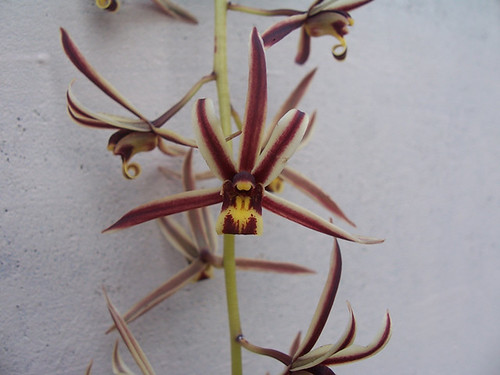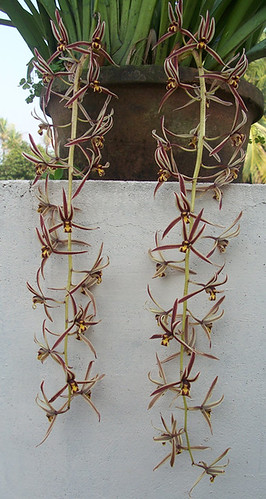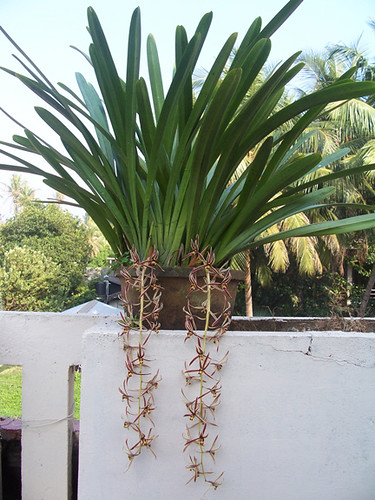This is a pretty orchid with short-lived flowers that last only a day but blooms several times a year. The trigger for blooming seems to be rainfall after a dry spell causing a drop in temperatures. The plant comes into bloom about 10 days from the trigger. The old flower stalks should not be removed as they are known to rebloom on old spikes. They can form specimen clumps quite fast and enjoy a lot of sunlight.
This blog is an attempt to describe the species, mostly those from the Western Ghats in as simple terms as possible. Constructive criticism is more then welcome as I am no botanist and would definitely benefit from learning.
Tuesday, November 1, 2011
Wednesday, October 26, 2011
Luisia abrahamii
Inflorescence: Short raceme with 2 to 3 flowers.
Flower size: About 3/4 of an inch across and about an inch in length.
Plant habit: Terete-leaved epiphyte with a drooping habit and roots that have a granular surface texture.
Altitude: A little inland at sea level to 400 metres asl.
Flowering time: Late September, October and early November.
Fragrance: None.
Distribution: Local endemic found only in Kerala.
Heat tolerance: Blooms well in the plains.
Flower size: About 3/4 of an inch across and about an inch in length.
Plant habit: Terete-leaved epiphyte with a drooping habit and roots that have a granular surface texture.
Altitude: A little inland at sea level to 400 metres asl.
Flowering time: Late September, October and early November.
Fragrance: None.
Distribution: Local endemic found only in Kerala.
Heat tolerance: Blooms well in the plains.
Monday, October 24, 2011
Dendrobium aqueum
Inflorescence: 2-3 flowers arise from the nodes opposite the leaves on the pseudobulbs.
Flower size: About 1 to 1.5 inches across.
Plant habit: Sympodial growth habit with pendulous pseudobulbs reaching up to 2 feet in length. The leafless canes are a deep maroon red. Found growing on trees covered in moss in considerable amount of shade.
Altitude: Above 900 metres asl.
Flowering time: September to October. It blooms from pseudobulbs that have just completed their growth during the monsoons.
Fragrance: Yes.
Distribution: Western Ghats.
Flower size: About 1 to 1.5 inches across.
Plant habit: Sympodial growth habit with pendulous pseudobulbs reaching up to 2 feet in length. The leafless canes are a deep maroon red. Found growing on trees covered in moss in considerable amount of shade.
Altitude: Above 900 metres asl.
Flowering time: September to October. It blooms from pseudobulbs that have just completed their growth during the monsoons.
Fragrance: Yes.
Distribution: Western Ghats.
Saturday, October 22, 2011
Polystachya concreta
This is a pan tropical species and a very peculiar looking sympodial orchid because it looks like a terrestrial but is epiphytic. The individual growths can measure anywhere between 2 to 6 inches in height and are found growing in a reasonable amount of shade at about 800 to 1000 meters asl. The non fragrant flowers are very tiny, about 3 mm across with floral segments which are green in colour except for the lip which is white and occupies a superior position. The flowers are arranged on a terminal branched raceme and bloom from June through August.
Friday, October 14, 2011
Eulophia graminea/epidendreae
Inflorescence: Upright branched raceme with sequentially opening flowers.
Flower size: About an inch across.
Plant habit: Terrestrial found growing in leaf litter and humus in rock crevices. The plant has a bulb like stem with alternating thin leaves.
Altitude: A little inland at sea level.
Flowering time: September to November.
Fragrance: None.
Distribution: India, Sri Lanka, South East Asia.
Heat tolerance: Blooms freely in the plains.
Hortus malabaricus name: Katou-Theka Maravara
Flower size: About an inch across.
Plant habit: Terrestrial found growing in leaf litter and humus in rock crevices. The plant has a bulb like stem with alternating thin leaves.
Altitude: A little inland at sea level.
Flowering time: September to November.
Fragrance: None.
Distribution: India, Sri Lanka, South East Asia.
Heat tolerance: Blooms freely in the plains.
Hortus malabaricus name: Katou-Theka Maravara
Friday, September 2, 2011
Cleisostoma tenuifolium
Inflorescence: Drooping raceme
Flower size: 7 mm across
Plant habit: Small-sized epiphyte with thin long leaves
Altitude: Sea level to 800 meters asl
Flowering time: July through September
Fragrance: None
Distribution: South West India, Sri Lanka and Thailand
Heat tolerance: Blooms in the plains
Hortus malabaricus name: Tsjerou mau maravara, Kolli tsjerou mau maravara
Flower size: 7 mm across
Plant habit: Small-sized epiphyte with thin long leaves
Altitude: Sea level to 800 meters asl
Flowering time: July through September
Fragrance: None
Distribution: South West India, Sri Lanka and Thailand
Heat tolerance: Blooms in the plains
Hortus malabaricus name: Tsjerou mau maravara, Kolli tsjerou mau maravara
Monday, August 1, 2011
Thursday, July 28, 2011
Aerides ringens
Status: Fairly common.
Altitude: Sea level to 2300 m.
Plant habit: Epiphytic with narrow long leaves.
Inflorescence: Raceme with some secondary branching.
Flowers: 0.5 cm across and 1.5 cm in length. Colours vary from pale pink at sea level to deep magenta at higher altitudes.
Flowering: Mar to April at higher altitudes and June to July at lower altitudes.
Endemism: Southern India and Sri Lanka.
Fragrance: No.
Heat tolerance: Blooms at sea level.
Altitude: Sea level to 2300 m.
Plant habit: Epiphytic with narrow long leaves.
Inflorescence: Raceme with some secondary branching.
Flowers: 0.5 cm across and 1.5 cm in length. Colours vary from pale pink at sea level to deep magenta at higher altitudes.
Flowering: Mar to April at higher altitudes and June to July at lower altitudes.
Endemism: Southern India and Sri Lanka.
Fragrance: No.
Heat tolerance: Blooms at sea level.
Sunday, June 26, 2011
Rhytionanthos rheedei
Status: Not common.
Habit: Crawling epiphyte.
Altitude: 800 metres asl.
Inflorescence: Umbel with 2 to 4 flowers.
Flowers: Shoe shaped flowers measuring about 7 mm in length.
Flowering season: June and July.
Fragrance: No.
Heat tolerance: Blooms at lower altitudes.
Hortus Malabaricus name: Tsjerou Tecka Maravara
Endemism: Kerala, Karnataka.
Habit: Crawling epiphyte.
Altitude: 800 metres asl.
Inflorescence: Umbel with 2 to 4 flowers.
Flowers: Shoe shaped flowers measuring about 7 mm in length.
Flowering season: June and July.
Fragrance: No.
Heat tolerance: Blooms at lower altitudes.
Hortus Malabaricus name: Tsjerou Tecka Maravara
Endemism: Kerala, Karnataka.
Saturday, June 18, 2011
Rhynchostylis retusa
Status: Quite common.
Plant habit: Vandaceous epiphyte with striped leaves and thick long roots.
Inflorescence: Drooping raceme with about 100 flowers.
Flower size: About 1.5 cm across.
Altitude: A little inland at sea level to 800 meters asl.
Flowering time: June and July.
Fragrance: Citrus fragrance.
Heat tolerance: Blooms at sea level.
Endemism: India, Sri Lanka and South-East Asia.
Hortus malabaricus name: Ansjeli maravara and Biti maram maravara.
Plant habit: Vandaceous epiphyte with striped leaves and thick long roots.
Inflorescence: Drooping raceme with about 100 flowers.
Flower size: About 1.5 cm across.
Altitude: A little inland at sea level to 800 meters asl.
Flowering time: June and July.
Fragrance: Citrus fragrance.
Heat tolerance: Blooms at sea level.
Endemism: India, Sri Lanka and South-East Asia.
Hortus malabaricus name: Ansjeli maravara and Biti maram maravara.
Sunday, May 15, 2011
Vanda testacea
Status: Not rare.
Plant habit: Epiphyte.
Inflorescence: Raceme.
Flower size: 1 to 1.5 cm yellow flowers with a blue lip.
Altitude: 400 to 800 metres asl.
Flowering time: March to April.
Fragrance: Yes.
Heat tolerance: Blooms at sea level.
Endemism: Burma, India, Sri Lanka, Thailand, Southern Yunnan.
Plant habit: Epiphyte.
Inflorescence: Raceme.
Flower size: 1 to 1.5 cm yellow flowers with a blue lip.
Altitude: 400 to 800 metres asl.
Flowering time: March to April.
Fragrance: Yes.
Heat tolerance: Blooms at sea level.
Endemism: Burma, India, Sri Lanka, Thailand, Southern Yunnan.
Loads of V. testacea on a tree
Variety from Coimbatore district
Variety from Wynad district
Photos: Courtesy Deepakkumar Sivarajan.
Smithsonia viridiflora
This is really orchid season. All those little orchids blooming up in those trees, very nicely camouflaged and visible only to the trained eye. Smithsonia is a genus that is endemic to South India and is represented by 3 species namely S. maculata, S. straminea and S. viridiflora. Smithsonia viridiflora was seen blooming in the lower elevations of the Western Ghats in May. The flowers measure about a centimetre across.
Tuesday, April 26, 2011
Vanda wightii versus Vanda thwaitesii
Earlier, having only seen pictures of both V. wightii and V. thwaitesii which were not too clear, I was confused as to what differentiated the two species. From what I could make of the images, both were a tan colour with white lips. No further detail was evident from these pictures. I have grown both V. wightii and V. thwaitesii in my greenhouse but since V. thwaitesii is from a higher elevation, it failed to bloom for me. This year I had the opportunity to visit the natural habitat of V. thwaitesii, see it in bloom and take some pictures so as to clear the confusion related to the two species.
Listed below are the features that differentiate the two species.
Plant Morphology: Both of the species have curved leaves but V. thwaitesii is the smaller of the two with a mature plant with more than 20 leaves being under a foot tall. The internodes of V. thwaitesii are very small compared to V. wightii which has bigger internodes.
Plant habitat: Both of them are found in locations which receive sufficient light and a lot of air movement. V. wightii is found in the plains at 0 – 100 msl while V. thwaitesii is found at elevations of 800 – 1000 msl.
Flowering time: V. wightii blooms just after the monsoons during October and November while V. thwaitesii blooms in April and May.
Floral characteristics:
1. The lip of V. wightii is similar to that of V. tessellata while that of V. thwaitesii is heart shaped with 5 – 6 brown lines on the crest of the lip.
2. The side lobe of the lip of V. wightii is curved upwards like that of V. tessellata, the only difference being the tip is blunt. The side lobe of the lip of V. thwaitesii is long and pointed downwards.
3. Fragrance-wise, V. wightii is similar to V. tessellata but the fragrance is evident at dusk. V. thwaitesii has a fragrance during the day which is quite a familiar fragrance but I quite cannot relate it to anything right now.
4. Flower count: V. wightii has a flower count similar to that of V. tessellata; about 5-7 flowers on a spike. V. thwaitesii has a flower count of 2-3 flowers on a spike and very rarely 4 but the lesser flower count is made up for by the plant carrying an average of 2-3 spikes.
Vanda thwaitesii (L) and Vanda wightii (R)
Sunday, April 24, 2011
Gastrochilus acaulis
This is a small plant with flowers slightly more than a centimetre across. The inflorescence is short with the flowers held close to the plant. The small plant size coupled with the short inflorescence makes it a very compact plant and a specimen sized plant with multiple spikes is a sight to behold.
Vanda thwaitesii
Vanda thwaitesii was originally reported from Sri Lanka where it is now believed to be extinct. In India, it is found in the Western Ghats in the states of Kerala and Karnataka at elevations of about 800 to 1000 msl. It is a very compact vanda with arched leaves and very short internodes. The flowers are about 4 cm across and 4 cm in length and are very fragrant. Each inflorescence carries about 2 to 4 flowers and all the plants we saw carried 1-3 spikes. We found it blooming during mid April with most of the plants in bloom and a few in bud.
Friday, April 15, 2011
Cymbidium aloifolium
Finally the heat of summer has begun and Cymbidium aloifolium is bursting into bloom. This plant was first recorded as Kansjiram Maravara by Hendrik Adriaan van Rheede tot Drakenstein, the then Dutch Governer of Cochin in his Hortus Malabaricus which is a treatise on the medicinal plants found in the Malabar region of India which was the hub of the spice trade in those days. The plant was thus named because it was found growing on a Kansjiram tree (Strychnos nuxvomica). Maravara which is a corruption of Maravazha refers to orchids in general. This plant has leathery belt shaped leaves measuring between 25 and 60 cm long and about 3 cm wide. It blooms during the month of April with pendulous racemes carrying around 10 to 30 flowers which last for about a week. The flowers have a very faint musty smell to them.
Please note that this is the same plant referred to as Cymbidium bicolor in Du Puy & Cribb's 'The Genus Cymbidium'.
Subscribe to:
Posts (Atom)




















































